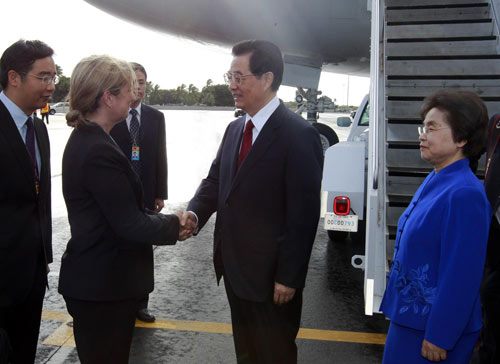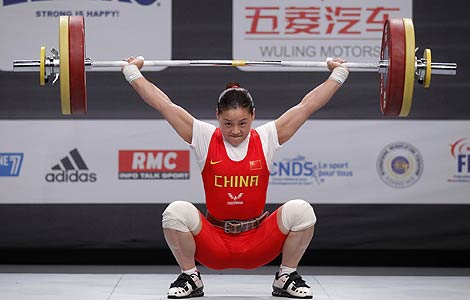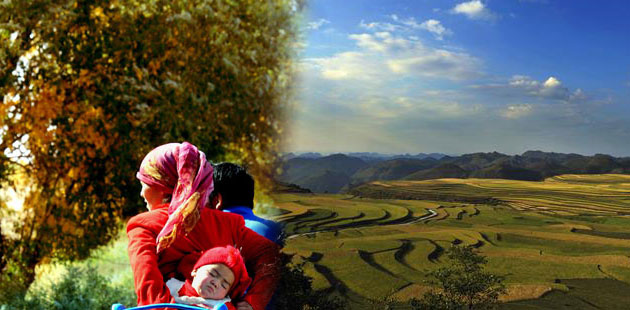Hu to focus on regional trade, growth
Updated: 2011-11-11 10:29
By Wu Jiao (chinadaily.com.cn)
|
|||||||||
|
 President Hu Jintao and his wife Liu Yongqing (right) arrived in Hawaii, Honolulu on November 10, 2011.[Photo/Xinhua] |
Upon landing at Joint Base Pearl Harbor-Hickam just before 8am, Hu, together with his wife Liu Yongqing, waved on the tarmac and smiled before leaving for Honolulu where he will attend the annual Economic Leaders Meeting of the Asia-Pacific Economic Cooperation (APEC) and meet business representatives from across the region.
| ||||
China and the US now stand as each’s second largest trade partner, with trade volume rising 150 times to $385 billion in 2010 since they established diplomatic ties in 1979. Diplomats said Hu’s direct talks with major US businesses are expected to be fruitful.
Amid wide coverage of the summit and of Hu’s attendance by the US media, the Hawaii News Now website reported that Hu is “one of the highest-profile APEC delegates”, noting that “this is the Chinese president’s first visit to the islands”.
The APEC leaders’ meeting, with the theme of “seamless regional economy”, will focus heavily on issues such as regional economic integration, green growth, energy security and regulatory cooperation.
Hu is expected to speak at the meeting on Sunday, focusing on improving global economic governance, shifting growth methods and promoting global and regional economic integration, Chinese foreign ministry officials said earlier this week.
Assistant Foreign Minister Wu Hailong said the president will also explain “China’s stand on the issues of free and open trade and investment, green growth, the adjustment of economic structure and regulatory cooperation”.
During the Sunday meeting, Hu will join other APEC leaders in a discussion with the APEC Business Advisory Council (ABAC) on issues including regional economic integration, reform of the international monetary system and food security.
The Chinese leader is also scheduled to deliver a speech titled “Redefining the Future” at the APEC CEO summit Saturday. Among his many other commitments, he is expected to hold bilateral meetings with leaders of APEC economies, including US President Barack Obama and newly elected leaders such as Japanese Prime Minister Yoshihiko Noda and the Vietnamese President Truong Tan Sang.
“China hopes the meeting will further promote free and open trade and investments in the Asia-Pacific region, push forward economic and technology cooperation, support multilateral trade systems and oppose trade protectionism to inject vitality into the world economic recovery,” Assistant Commerce Minister Yu Jianhua said at a press briefing earlier this week.
The 21 member economies of APEC, a major economic forum for the Asia-Pacific region, now account for 43 percent of global trade and 55 percent of global economic activity. It has contributed more than 70 percent of global economic growth during the past decade. Observers say continuous growth in the bloc matters not only to the region but to the global economic recovery.
The region currently faces economic uncertainties, with some of APEC’s developing members mired in over-investment ventures, inflation and rising energy prices.
The depreciation of the US dollars and the gloomy global economic outlook is adding to the vulnerability of the region where developing economies rely heavily on exports to developed countries.
China, which joined the regional forum 20 years ago, has become a major growth engine for the bloc and a top trade and investment partner for many of the bloc’s members. A survey of 320 business CEOs within the Asia-Pacific bloc by PricewaterhouseCoopers, released this week, show that more than 40 percent of the investments by both domestic and non-Chinese companies, are aimed at China.
Observers said it is not only important to the region that economic growth continue among the organization’s members, but also to the world.
Even so, they face economic uncertainty, especially the members that still have developing economies. Many of them are experiencing troubles stemming from over-investment, input inflation and increasing energy prices.
Chinese diplomats, even though they in general look with favor upon the agenda set by the US, have said some of its goals are “too ambitious”.
For instance, the US, a maker of many varieties of green technology, is trying to persuade other countries or regions in Asia-Pacific Economic Cooperation to limit the tariff rates placed on a broad range of green products and services to a maximum of 5 percent by 2012.
The organization’s members are divided over what products and services should be subject to the proposed rule.
“On the whole”, they look favorably on the US’ proposals, but think some of Washington’s expectations would place too great of a demand on “the abilities of the majority of the developing member economies”, Wu Hailong, assistant foreign minister, said on Monday.
Such members have already expressed “concerns”, and all of those involved expect the meeting to produce “balanced and concrete results”, Wu said.
The developing countries and regions also want the US and other developed countries to make a greater commitment to transferring technology.
Su Hao, director of the Asia-Pacific research center at China Foreign Affairs University in Beijing, said the US’ proposals are meant to strengthen its trade advantages in the Pacific Rim and to cause developing countries and regions to become more dependent on its technology.
Lu Jianren, an Asia-Pacific Research Center expert at the Chinese Academy of Social Sciences, said the arrangements will set a “very high standard” and the vast economic disparities that exist within the Asia-Pacific make it difficult to integrate the region as quickly as the US wants.
“For example, developing economies usually have higher tariffs than developed economies,” he said. “A sudden cut in tariffs will only benefit rich economies to the detriment of some vulnerable domestic industries in developing economies.”
Zheng Yangpeng contributed to this story.













